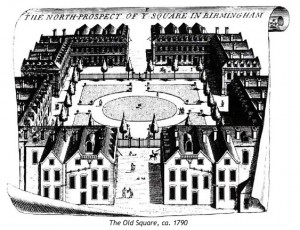A Ramble Round Old Birmingham
Follow this link and you will find a chapter from a fabulous book which looks at the coin making business in Birmingham in the 18th and 19th centuries. The blurb for George Selgin’s Good Money: Birmingham Button Makers the Royal Mint and the beginnings of Modern Coinage, 1775 – 1821 says:
He tells of the stories of the [Birmingham] merchants, the button makers who turned into coin makers, the way the system worked, its wonderful innovations and its evolution, and reveals the cruelty and destructiveness behind the government’s suppression of the industry.
The industry developed to the point at which 20 independent mints were involved in making coins. The private coins served the merchants and the workers, while the government’s currency served the landed rich. The new industry was like capitalism itself: it was designed for everyone to the benefit of everyone.
The private coins tended to be better quality than the government’s coins. Why? Because private merchants could refuse them, and consumers could too. There was competitive control over them and an inexorable tendency for currency to improve in every way. That’s why the book is called “good money.”
And what of Gresham’s Law, the tendency of “bad money” to drive out good money? Selgin’s account demonstrates something striking: it only holds under government system of money which overvalue bad money. In a private system, good money—like good products and services in a free markets—outcompetes the low-quality money. In a market-based money system, there is an inexorable tendency for good money to win out.
In this chapter he writes a fascinating “ramble” around old Birmingham, starting at what was then called the Old Square and it connection with Lloyd’s Bank:
The Square itself, though, has some (admittedly slim) connections to commercial coinage, or to Matthew Boulton at any rate, we’ll linger here a bit.
The first connection has to do with Samuel Lloyd III, the son of one of the founders of Birmingham’s first bank, who lived at No. 13, on the north side, before he joined the general flight to the suburbs. It was during a visit to Lloyd here in ’76 that Samuel Johnson threw a fit while Boswell read him a passage from Barclay’s Apology: ol’ Dictionary got so riled that he grabbed the book, flung it to the ground, and stomped on it. The next morning Johnson was still fuming, so Boswell decided to get clear of him by visiting Soho. During his tour Matthew Boulton said to him, “I sell here, sir, what all the world desires to have — power.” This was of course well before Boulton turned mint master — an occupation that would obsess him even more than making steam engines did.
Just up the street from Lloyd’s old address, at 20 Upper Priory, lived and worked another person with a connection — this time a substantial one — to token coinage. Benjamin Patrick sank dies for several commercial tokens in the ’90s, having taken over his father’s toy business several years before. In 1811, when he’d relocated north of here to Bath Street, Patrick sank some dies for Thomas Halliday. He also engraved a private penny token for one William Booth of Perry Barr, which was part of Handsworth parish.
You can find the book on amazon here. If you read the whole thing and fancy writing a review please get in touch and we’ll put it on this site. Special thanks to D’log for finding this link.




